The 14th National Conference of Young Fisheries Scientists reaffirmed the vital role of innovation in enhancing productivity, quality, and value in Vietnam’s fisheries sector.
On October 10, 2025, the 14th National Conference of Young Fisheries Scientists was jointly organized by Vietnam National University of Agriculture (VNUA) and the Research Institute for Aquaculture No. I, under the theme “Vietnam’s Young Fisheries Science: Innovation – Creativity – Integration.”
This annual event, maintained by the Vietnam Fisheries Network of Institutes and Universities (VIFINET), aimed to promote scientific and technological activities, foster collaboration, and facilitate knowledge exchange among lecturers, young scientists, researchers, graduate students, and undergraduates in the fisheries field.
The conference welcomed representatives from the Department of Science and Technology, the Directorate of Fisheries and Fisheries Surveillance, Ministry of Agriculture and Environment, and leaders from research institutes and universities both within and outside the VIFINET network.
From VNUA, attendees included Prof. Dr. Tran Duc Vien, Chairman of the University Council; Dr. Nguyen Cong Tiep, Vice President; Assoc. Prof. Dr. Kim Van Van, Dean of the Faculty of Fisheries, along with leaders of different departments, faculties, and Publishing House.
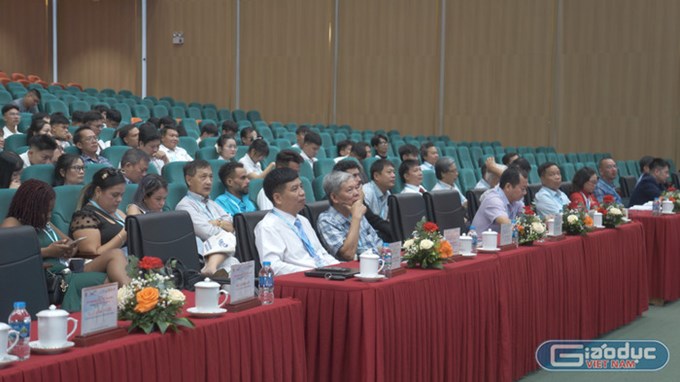
Overview of the Conference: Photo by: Dao Hien.
In his opening remarks, Dr. Nguyen Cong Tiep, VNUA’s Vice President, emphasized that this year’s conference was not only a platform for sharing the latest knowledge in science and technology but also contributed to the implementation of Resolution No. 57-NQ/TW of the Politburo on strengthening national science, technology, innovation, and digital transformation, thereby aiming to enhance competitiveness, increase value, and promote the sustainable development of Vietnam’s fisheries sector.
He believed that the Conference was a valuable opportunity for lecturers, young scientists, PhD candidates, graduate students, and undergraduates to exchange experiences, establish long-term research collaborations, and build a dynamic, creative, and internationally integrated Vietnamese fisheries science community.
In 2025, the 14th National Conference of Young Fisheries Scientists received over 180 scientific papers, of which 55 were peer-reviewed and published in three accredited journals recognized by the State Professorship Council, including the Vietnam Journal of Agricultural Sciences (Vietnamese version and English version) and the Journal of Agriculture and Environment.
Additionally, 127 research reports were presented, including 60 oral and 67 poster presentations, divided into five specialized subcommittees: (i) Aquaculture Technology and Environment; (ii) Genetics and Breeding; (iii) Nutrition and Feed; (iv) Aquatic Animal Diseases; and (v) Fisheries Economics, Processing, and Resource Management.
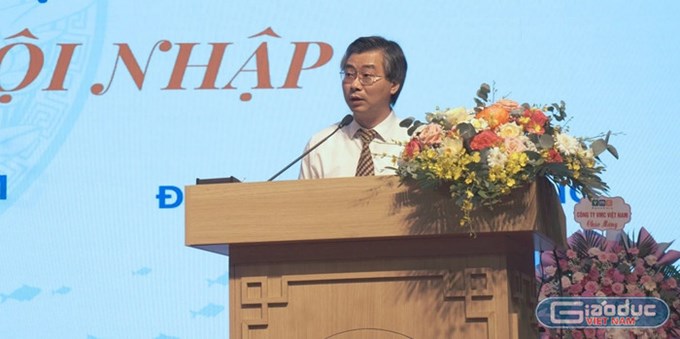
Dr. Nguyen Cong Tiep, VNUA’s Vice President, delivers the opening remarks at the Conference. Photo by Dao Hien.
Meanwhile, Dr. Tran Dinh Luan, Director General of the Directorate of Fisheries and Fisheries Surveillance, emphasized that “Science and technology have never been as critical to fisheries development as they are today. The conference plays a meaningful role in implementing Resolution No. 57-NQ/TW, providing opportunities to apply new technologies effectively and sustainably in fisheries production. This is also an opportunity for the sector to grasp the latest research findings, thereby guiding the effective and sustainable application of technology in aquaculture production”.
According to Dr. Luan, under the guidance of Resolution 57, science, technology, and digital transformation were creating new development pathways for Vietnam’s fisheries sector, particularly in aquaculture, which was identified as a key area in Decision No. 339 approving the Vietnam Fisheries Development Strategy to 2030, with a Vision to 2045 of the Prime Minister.
For the first time, the strategy set a goal to reduce marine capture production from 3.8 million tons to 2.8 million tons, while expanding sustainable aquaculture to compensate and enhance long-term resilience.
“With these goals, comprehensive application of science, technology, and innovation is imperative,” Dr. Luan noted. “I believe that with the pioneering role of scientists, research institutes, and universities, Vietnam will effectively harness scientific achievements to promote the modernization, integration, and sustainability of aquaculture, ensuring stable production and continued export growth in the coming time.”
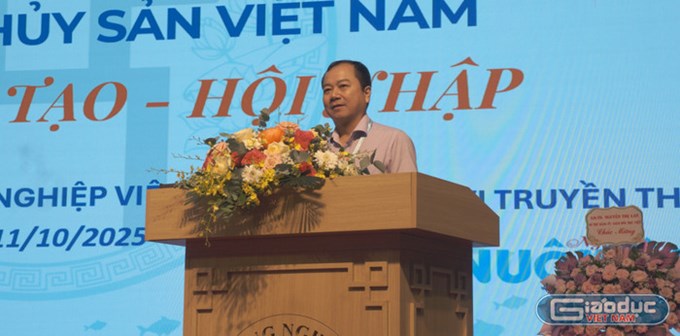
Dr. Tran Dinh Luan, Director General of the Department of Fisheries and Fishery Surveillance, shares his expectations for the Conference. Photo by Dao Hien.
Vietnam’s Fisheries experiencing stable growth, being the world’s third largest exporter
In a keynote presentation titled “Opportunities for Vietnam’s Fisheries Sector and the Role of the Young Generation,” Dr. Le Thanh Luu, former Director of the Research Institute for Aquaculture No. I and Co-founder of VIFINET, stated that Vietnam was currently the third-largest seafood exporter in the world, accounting for over 7% of global market share, behind only China and Norway.
Over the past three decades, Vietnam’s fisheries sector has maintained steady growth, contributing significantly to food security, generating jobs for around 4 million workers, and bringing substantial trade surplus to the country.
According to Dr. Luu, Vietnam’s major advantages were a skilled labor force, strong government support policies, modern logistics and processing systems, and export access to 190 countries and territories.
However, the sector still faced significant challenges, including climate change, intense regional competition, fragmented production, weak value-chain linkages, and limited innovation in breeding and applications of modern technology.
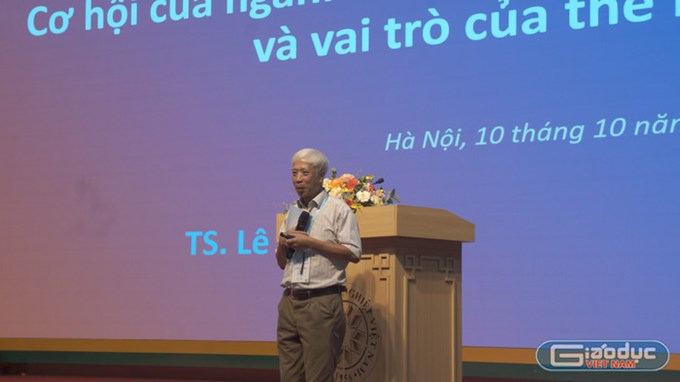
Dr. Le Thanh Luu presents the report entitled “Opportunities for Vietnam’s Fisheries Sector and the Role of the Young Generation.”
In light of this reality, he called upon young scientists to embrace creativity and proactively seek new solutions to foster sustainable fisheries development. “Innovation, technological advancement, and new approaches are essential,” he said, adding that the sector had to move toward carbon-neutral production by 2050, promote green and circular economies, and restructure production under cooperative or large-scale enterprise models, with strong adoption of digital technologies, AI, and automation for monitoring, productivity enhancement, and traceability.
At the conference, Assoc. Prof. Dr. Kim Van Van, Dean of the Faculty of Fisheries, VNUA, presented a research report entitled “Aquatic Animal Diseases in Vietnam.”
He noted that before the 1990s, aquaculture in Vietnam was limited, with few diseases and insufficient research infrastructure.
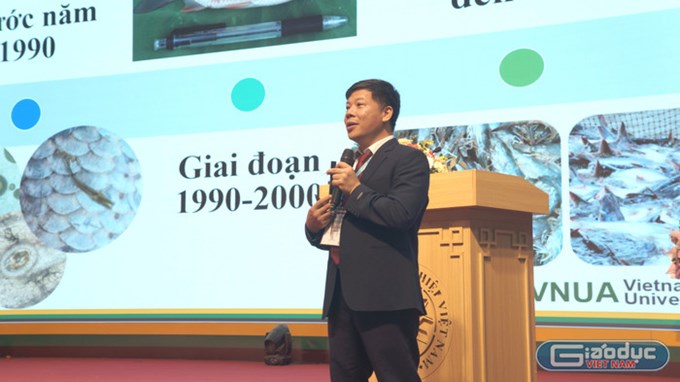
Associate Professor Dr. Kim Van Van, Dean of the Faculty of Fisheries, VNUA, presents his report.
From 1990 to 2000, as black tiger shrimp farming expanded, viral diseases became more prevalent, together with red spot disease in grass carp and ulcer disease in marine fish. Diagnosis methods mainly relied on histopathology, and researchers received training from Thailand.
Since 2000, as aquaculture techniques, feed, and veterinary products advanced, diseases had become more frequent and complex. The Faculty’s research group conducted multiple projects on Koi Herpes Virus (KHV) in carp and other aquatic species in northern Vietnam. They also explored the use of herbal medicines such as betel leaf, phyllanthus, and solanum in disease prevention, as well as neem leaves, pumpkin seeds, and terminalia trees to control parasites, and almond, guava, and sim leaves in ornamental fish culture.
“While aquaculture in Vietnam has grown rapidly in scale and technology, disease challenges have also become more diverse and difficult to manage,” Dr. Van remarked. “Yet it is encouraging that many young scientists are now engaging in this field, producing promising research outcomes. These achievements will be a solid foundation for Vietnam’s aquaculture to continue innovating, enhancing disease prevention and control, and advancing toward safe, modern, and sustainable development in the future.”